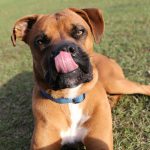Bloat in Great Danes can escalate quickly to a life-threatening emergency. Recognizing the early signs is vital for your dog's well-being. Symptoms such as restlessness, pacing, or a distended abdomen should never be overlooked. Immediate intervention can make all the difference. This guide offers essential steps to ensure your beloved companion receives timely care, potentially saving their life. Read on to empower yourself with crucial knowledge that could prevent a tragedy.
Understanding Bloat in Great Danes
Bloat in dogs, medically known as gastric dilatation-volvulus (GDV), is a life-threatening condition that requires immediate attention. This condition occurs when a dog's stomach fills with gas, fluid, or food and then twists, leading to severe complications. For Great Danes, the risk of developing bloat is significantly higher due to their large, deep-chested anatomy. Understanding the severity and early signs of bloat is crucial for any Great Dane owner.
Dans le meme genre : Key Elements for Crafting a Wholesome Raw Diet for Your Growing Boxer Puppy
Overview of Bloat and Its Severity
Bloat in dogs can escalate rapidly, causing distress and potential death if not treated promptly. The twisting of the stomach prevents blood flow, leading to tissue death and systemic shock. Recognizing this severity underscores the need for vigilance in monitoring your pet's health.
Specific Risk Factors for Great Danes
Great Danes are predisposed to gastric dilatation-volvulus due to their size and chest conformation. Factors such as rapid eating, excessive drinking, and high-stress levels can increase the risk. Genetics also play a role, making it essential to be aware of your dog's family history.
A lire en complément : Identifying and Managing Early Cataracts in Your Boston Terrier: A Comprehensive Guide
Importance of Recognizing Early Signs
Early detection of bloat in Great Danes is vital. Signs include a distended abdomen, unproductive retching, restlessness, and drooling. Immediate veterinary care can save your dog's life, emphasizing the importance of prompt action when these symptoms are observed.
First Signs of Bloat
Recognizing the early signs of bloat in Great Danes can be the difference between life and death. One of the most noticeable symptoms of bloat is abdominal swelling. This distension is often visible and can be alarming. The abdomen may appear tight and drum-like, indicating the stomach's dangerous expansion.
Another critical sign is unsuccessful attempts to vomit. A dog experiencing bloat may retch repeatedly without producing any vomit. This is a red flag that the stomach is twisted, preventing contents from being expelled. It's crucial to act swiftly if you notice this behaviour.
In addition to physical symptoms, Great Danes may exhibit signs of distress and discomfort. They might pace restlessly, unable to find a comfortable position. This agitation is due to the pain and pressure caused by the distended stomach. Other behavioural changes include excessive drooling and whining, which can indicate severe discomfort.
Understanding these early signs and symptoms of bloat is essential for any Great Dane owner. Prompt recognition and immediate veterinary intervention can significantly improve the chances of recovery, underscoring the importance of vigilance in monitoring your dog's health.
Immediate Actions to Take
When facing a bloat emergency with your Great Dane, swift action is crucial. Begin with an initial assessment of your dog's condition. Look for signs of distress such as a distended abdomen and unproductive retching. This assessment will guide your next steps in bloat management.
Once you suspect bloat, contact a veterinarian immediately. Time is of the essence, as the condition can deteriorate rapidly. Explain the symptoms clearly to the vet, emphasizing the urgency. This will help them prepare for your arrival and provide the best possible care.
While waiting for professional help, there are limited first aid for dogs measures you can take. Avoid giving food or water, as this can exacerbate the situation. Focus on keeping your dog calm and comfortable to prevent further stress.
Prepare for transport to the vet by ensuring your dog is secure and comfortable in the vehicle. If possible, have someone accompany you to monitor your dog's condition during the journey. This allows you to focus on driving safely while ensuring your pet remains stable.
By following these emergency response steps, you can improve the chances of a positive outcome for your Great Dane.
Urgent Care Recommendations
When you arrive at the veterinary clinic with a Great Dane suspected of bloat, expect swift and decisive action. The veterinary team will prioritize stabilizing your dog, often starting with intravenous fluids to combat shock and dehydration. Emergency veterinary services will likely include an X-ray or ultrasound to confirm the diagnosis of gastric dilatation-volvulus (GDV).
Possible Treatments and Interventions
Once GDV is confirmed, immediate bloat treatment is necessary. The primary intervention is decompression of the stomach, which may involve passing a tube or using a needle to relieve gas pressure. Surgery is often required to untwist the stomach and possibly tack it to the abdominal wall to prevent recurrence, a procedure known as gastropexy.
Recovery Process and Follow-up Care
Post-surgery, your Great Dane will need close monitoring, typically remaining in the clinic for a few days. Recovery involves pain management, gradual reintroduction of food and water, and monitoring for complications such as infection or arrhythmias. Follow-up care is crucial; regular veterinary check-ups will ensure the recovery process is on track. Discuss with your vet any lifestyle adjustments needed to minimize future risks, such as dietary changes or stress reduction strategies.
Preventive Measures for Great Danes
To effectively prevent bloat in Great Danes, proactive measures focusing on diet management and exercise routines are crucial.
Recommended Feeding Practices
Feeding practices play a significant role in reducing the risk of bloat. It is advisable to provide smaller, frequent meals rather than one large meal. This approach helps in managing the stomach's load and minimizes the chances of gastric dilatation. Avoid using elevated food bowls, as these can increase the risk of bloat. Ensure your Great Dane eats slowly by using a slow feeder bowl to prevent rapid ingestion of air.
Importance of Gradual Exercise
Exercise routines should be carefully planned around meal times. Vigorous activity immediately after eating can exacerbate the risk of bloat. It's important to allow your Great Dane to rest for at least 1-2 hours post-meal before engaging in any strenuous activity. This period allows the stomach to settle, reducing the likelihood of twisting.
Monitoring Behaviors and Habits
Being observant of your Great Dane's habits is essential. Monitor their eating speed, stress levels, and any changes in behaviour. Stress can be a significant factor, so maintaining a calm environment is beneficial. Regular vet check-ups can also help in early detection of any potential issues.
Expert Advice and Testimonials
Gaining insights from veterinarian insights and real-life experiences can significantly enhance your understanding of bloat in Great Danes. Veterinarians stress the importance of early detection and intervention. Dr. Emily Thompson, a renowned veterinary surgeon, emphasizes, "Recognizing the signs of bloat early can save your dog's life. Immediate veterinary attention is crucial."
Many Great Dane owners have shared their experiences, highlighting the importance of vigilance. Sarah, a devoted pet owner, recounts, "When Max started pacing and retching, I knew something was wrong. Thanks to our vet's advice, we acted quickly, and it saved him."
Regular veterinary check-ups are indispensable in maintaining your dog's health and preventing bloat. These visits allow for early detection of any predispositions or symptoms. Dr. Mark Lewis advises, "Routine check-ups can identify potential risk factors early on, ensuring timely management."
Expert opinions underline the significance of being proactive. Regular monitoring and understanding your dog's behaviour can make a difference. Veterinarians recommend keeping a close eye on eating habits and stress levels to mitigate risks. By combining professional advice with real-life pet care testimonials, you can be better prepared to protect your Great Dane from the dangers of bloat.
Visual Aids and Infographics
Visual aids, such as bloat infographics, play a critical role in enhancing understanding of this life-threatening condition in Great Danes. These educational graphics can simplify complex medical information, making it accessible and easier to grasp for dog owners. By presenting symptoms and emergency actions visually, infographics help in quick recognition and response, which is vital during a bloat episode.
Benefits of Using Visual Aids
Visual aids offer several benefits. They can highlight key symptoms and steps to take in an emergency, ensuring that even under stress, owners can recall necessary actions. Infographics often use colour coding and icons to represent different stages and severity of bloat, aiding in faster comprehension.
Examples of Infographics
Some infographics illustrate the progression of bloat, showing symptoms like abdominal swelling and unproductive retching. Others may depict emergency actions, such as contacting a veterinarian and avoiding food or water intake. These dog health visuals serve as quick references in urgent situations.
Suggested Resources
For further visual education, resources like veterinary clinics or pet health websites often provide downloadable infographics. These resources can be invaluable, offering educational graphics tailored to specific breeds and their unique health challenges.
Resources for Pet Owners
Navigating the complexities of Great Dane care requires access to reliable pet owner resources. Fortunately, there are numerous Great Dane care guides available that can provide valuable insights and support.
Recommended Books and Websites
For comprehensive bloat information and general care tips, several books and websites stand out. Titles like "The Great Dane Care Guide" offer in-depth advice on managing this breed's unique needs. Websites such as the Great Dane Club of America provide detailed articles and expert recommendations.
Support Groups and Forums
Connecting with other Great Dane owners can be incredibly beneficial. Online support groups and forums offer a platform to share experiences and advice. These communities can provide emotional support and practical solutions for dealing with bloat and other health issues.
Educational Videos and Webinars
Visual learning tools such as educational videos and webinars can enhance your understanding of canine health. Many veterinary clinics and pet health websites offer webinars focused on bloat prevention and management. These resources can be especially helpful for those who prefer interactive learning experiences.
By utilizing these pet owner resources, you can ensure that you are well-equipped to care for your Great Dane and address any health concerns that may arise.
Conclusion
Understanding bloat awareness is crucial for ensuring the safety of your Great Dane. As a pet owner, recognizing the early signs and acting swiftly can save your dog's life. Dog health safety is a responsibility that requires vigilance and knowledge about potential health risks.
Owning a Great Dane involves a significant level of pet owner responsibility. This means not only providing love and care but also being equipped with the necessary knowledge to prevent and manage health issues like bloat. Regular monitoring of your dog's behaviour and maintaining a stress-free environment are integral parts of this responsibility.
By staying informed and proactive, you can significantly reduce the risk of bloat and ensure your Great Dane leads a healthy, happy life. Remember, your attentiveness and prompt actions are vital components of dog health safety. Prioritizing these aspects can make a world of difference in your pet's well-being.











